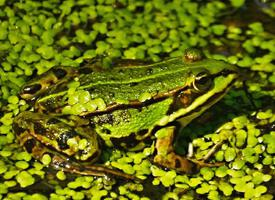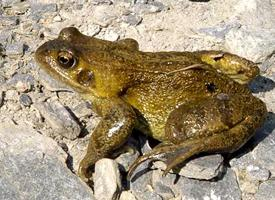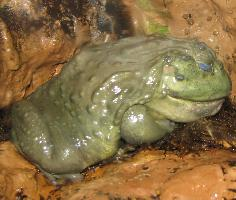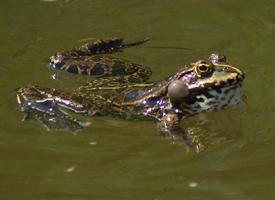
Váhy a míry
| Délka | od 8,5 do 10 cm |
|---|
Popis zvířete
The Edible Frog (Pelophylax esculentus) is a fascinating amphibian species that is widely distributed across Europe. This species is particularly notable for its distinctive physical characteristics and its unique place within various ecosystems. As its name suggests, the Edible Frog has been a part of human cuisine in certain cultures, highlighting its significance beyond just its biological role.Physical Appearance:
The Edible Frog is a medium-sized amphibian, with males typically reaching lengths of about 8-9 centimeters, while females can grow slightly larger, up to 12 centimeters. They exhibit a vibrant green coloration on their dorsal side, interspersed with dark blotches that provide camouflage among vegetation. Their belly is usually lighter, ranging from white to a light green. One of the most striking features of the Edible Frog is its large, bulging eyes, which are not only captivating but also provide a wide field of vision for spotting predators and prey. Additionally, they have long, powerful hind legs, adapted for both swimming in water and leaping on land.
Habitat and Distribution:
The Edible Frog is primarily found throughout much of Europe, from France in the west, extending eastward to Ukraine and parts of Russia. Its habitat is largely centered around freshwater environments such as ponds, lakes, marshes, and slow-moving rivers. These amphibians are highly dependent on the presence of water, not only for breeding but also as a crucial component of their diet and survival.
Diet and Behavior:
Edible Frogs are opportunistic feeders and primarily carnivorous. Their diet mainly consists of insects, spiders, snails, and occasionally small fish and tadpoles. They employ a sit-and-wait strategy, using their excellent camouflage to remain undetected until prey comes within reach. At that moment, they use their long, sticky tongues to capture the prey swiftly.
Reproduction:
The breeding season for Edible Frogs typically occurs from late spring to early summer. Males attract females through a distinctive croaking sound, which is amplified by their vocal sacs. After mating, females lay thousands of eggs in water bodies, which are then fertilized externally by the males. The eggs hatch into tadpoles, which undergo metamorphosis over several months, eventually emerging as juvenile frogs.
Conservation Status:
Currently, the Edible Frog is not considered to be at risk of extinction and is classified as Least Concern by the IUCN Red List. However, like many amphibians, they face threats from habitat destruction, pollution, and climate change. Conservation efforts are essential to ensure the stability of their populations and the ecosystems they inhabit.
Cultural Significance:
In certain European cuisines, notably French, the legs of the Edible Frog are considered a delicacy. This culinary tradition has led to the species being farmed in some regions, although wild populations are also harvested.
In conclusion, the Edible Frog is a remarkable amphibian with a wide range of interesting characteristics, from its vivid green coloration and dietary habits to its role in human culture. Despite its current stable status, ongoing conservation efforts are crucial to protect this species and the wetland habitats it calls home.
Podobná zvířata
Nové fotografie zvířat
Top 10 zvířat
- Chinese water dragon (Physignathus cocincinus)
- Galápagos tortoise (Geochelone nigra complex)
- Dolphin gull (Leucophaeus scoresbii)
- Japanese macaque (Macaca fuscata)
- Colombian red howler (Alouatta seniculus)
- Sea urchins (Echinoidea)
- Moustached guenon (Cercopithecus cephus)
- Diana monkey (Cercopithecus diana)
- Common reed warbler (Acrocephalus scirpaceus)
- Common house mosquito (Culex pipiens)


